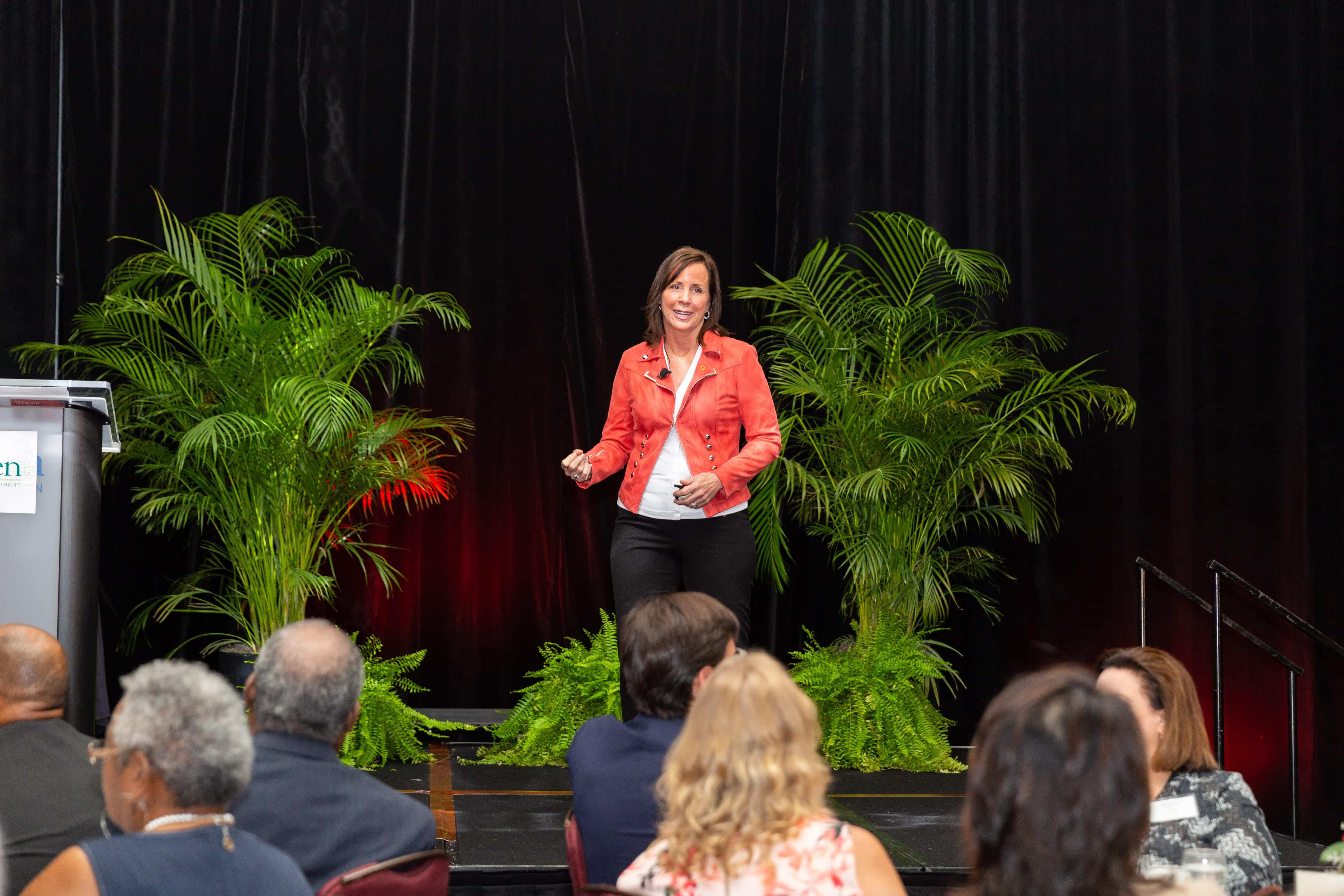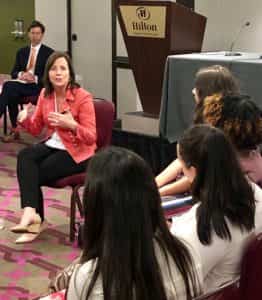Thrive
Philanthropist, entrepreneur tells USF leaders to look fear in the eye and push past it

There’s a strong connection between business failure and innovation.
People who try new ideas are taking a risk that they will fail. The key is how they handle that failure, said Jean Case, CEO of the Case Foundation and chairman of the National Geographic Society.
Case talked to the St. Pete Catalyst Oct. 4, just before her keynote address at the University of South Florida Women in Leadership & Philanthropy annual symposium. The daylong coaching and mentoring event drew more than 1,100 attendees.
Case knows quite a bit about innovation. She’s a former senior executive at AOL, the website and online service provider co-founded by her husband, Steve Case. He’s now chairman and CEO of the Washington, D.C.-based venture capital firm Revolution, and brought the Rise of the Rest tour, an initiative to focus on promising startups outside of major technology hubs, to Tampa-St. Pete earlier this year.
Earlier this year, Jean Case published Be Fearless: 5 Principles for Breakthrough and Purpose, a book that outlines a framework for entrepreneurs. The principles are:
- Make big bets
- Be bold, take risks
- Make failure matter
- Reach beyond your bubble
- Let urgency conquer fear
Case described how those principles can bring about transformational change in the for-profit and non-profit sectors.
Catalyst: What inspired you to write the book?
Case: I have an unusual background in that I spent a couple of decades in tech before I founded the Case Foundation. I’m also chairman at National Geographic. That has taken me all over the United States and all over the world. One thing I could see in common no matter where I was, was people everywhere have great ideas. Our mission at the Case Foundation is that we invest in people and ideas that can change the world, and I often query, why haven’t you done something with that idea? If you have this great idea, what have you done to take it forward?
I could see the look in the eye, the body language — “oh that can’t be me, I don’t have what it takes.” And they would go forward with a number of different qualities they presumed you needed to have in order to break through with a new idea.
In 2012, we decided to go to school on this. I was really quite animated by this issue of why do some break through and some don’t. We hired a team of researchers and they looked across sectors, across geographies and across time at transformational breakthroughs and successes and found there were five simple but powerful principles at work. More importantly, they found it is ordinary people who do extraordinary things. You don’t have to have a certain college degree. You don’t have to have a special genius. You don’t have to be well connected. It really is the application of these five principles.
That was the genesis of our Be Fearless work. Then as we began sharing it across the country and around the world, people said, have you thought about writing a book about it, because it really needs to be told. That was the genesis of the book.

Jean Case talked with USF students during the symposium. (Photo credit: USF Women in Leadership & Philanthropy)
Catalyst: What’s the connection between being fearless and innovation?
Case: Although the book is called Be Fearless, I make it very clear that being fearless is not the lack of fear but the ability to look fear in the eye and push past it.
You look at the life of any entrepreneur, change-maker, innovator, inventor and those principles are very much at work. So it has everything in the world to do with innovation because the bottom line is, if you are innovating you are doing something new that’s never been proven before. By its very nature, you are taking a risk and by its very nature you are risking that failure might be an outcome. It’s actually what you do with that failure that determines if you push forward.
I like to talk about how in science and medicine and technology we understand the role of R&D [research and development], which is trying a bunch of stuff, going into it knowing maybe most of it won’t work, but you’re looking for one thing that will. Thomas Edison said, “I haven’t failed, I’ve found 10,000 things that won’t work.”
That mindset — if you could look at innovation or taking an idea forward in your own life, in your own work —as R&D, it changes the perspective. It takes away the power of fear and it takes away the power of failure, because now you are going into it saying some things are going to work and some things aren’t. When I find something doesn’t, I’m going to use that as a teachable moment to perfect my idea.
Catalyst: I interview so many CEOs and corporate leaders who, I don’t know if they would use these words, but they appear to me to be risk-averse.
Case: Oh totally that’s true. When I wrote the book, and actually when we created the research, we really thought we were addressing the nonprofit, philanthropic and government sectors. But it became clear right away that companies wanted to understand these principles and think about how they could apply them.
I use two examples of big companies getting it wrong in the book. I say, shouldn’t Blockbuster have been Netflix? Shouldn’t Kodak have been Instagram?
In both those cases, they were so busy defending what they had that they were unwilling to take the risk for what they might do in the future to stay relevant.
In Kodak’s case, digital photography was actually found/invented by two of their engineers. At the time Kodak had 80 percent market share of traditional film roles. I always laugh about, can you imagine those two guys going “Guess what we have! A way to make photographs without film!” It probably didn’t go over so well, right? But what’s the story? Kodak ends up in Chapter 11 and today Instagram is what we know, what we all use. We used to say Kodak moments. Now we say, “It’s a gram moment.” They have totally overtaken, because they were able to play offense and try something new when Kodak was busy defending what they had.
Catalyst: How does this relate to philanthropy?
Case: Philanthropy is a couple of different things. If you peel back the onion, there are all kinds of different philanthropies. My husband and I are what they call living donors in our philanthropy. We know that the resources were acquired through risk-taking in the company we built, so of course we have very much of a risk-taking approach in our philanthropy.
But so many big philanthropies have now been handed down to a second or third generation, to what I call caretakers. And I really get this. I say, if I was spending my own $100 I can take all kinds of crazy risks on that, but if you give me $100 now I’m going to get really cautious because I’m a steward of your assets. This is what we were seeing in philanthropy.
I have to give the philanthropy sector, particularly the older established philanthropies, great credit because I think they really have embraced the principles of Be Fearless and I’m not just saying because of our work. But certainly for all of those we’ve worked with, talking about how we might apply the Be Fearless principles, it’s remarkable today to see more willingness to take risks on the philanthropic front.
Catalyst: What challenges do you see ahead?
Case: One of the principles is called reach beyond your bubble, and it means build unlikely partnerships, with people who are different, with organizations who are different. We’ve always understood two heads are better than one, but it turns out, any study of innovation is not that lone genius in the garage. It’s people bringing different perspectives to a challenge or an opportunity.
So one of the things that I’ve also seen is a lot more collaboration in philanthropy. I think there’s an understanding that no one sector can do all it needs to do to make the impact it wants to have. We are so much better together.
We’ve always had cross-sector initiatives at the Case Foundation so it’s the foundation, usually a nonprofit or two, it’s a corporate, and another philanthropy. When you have all those oars rowing together, that’s when you can begin to see big scale and big impact, but if everyone is in their silos just trying to do their thing, there’s no amount of money and there’s no talent in any one sector that can the big things done.







